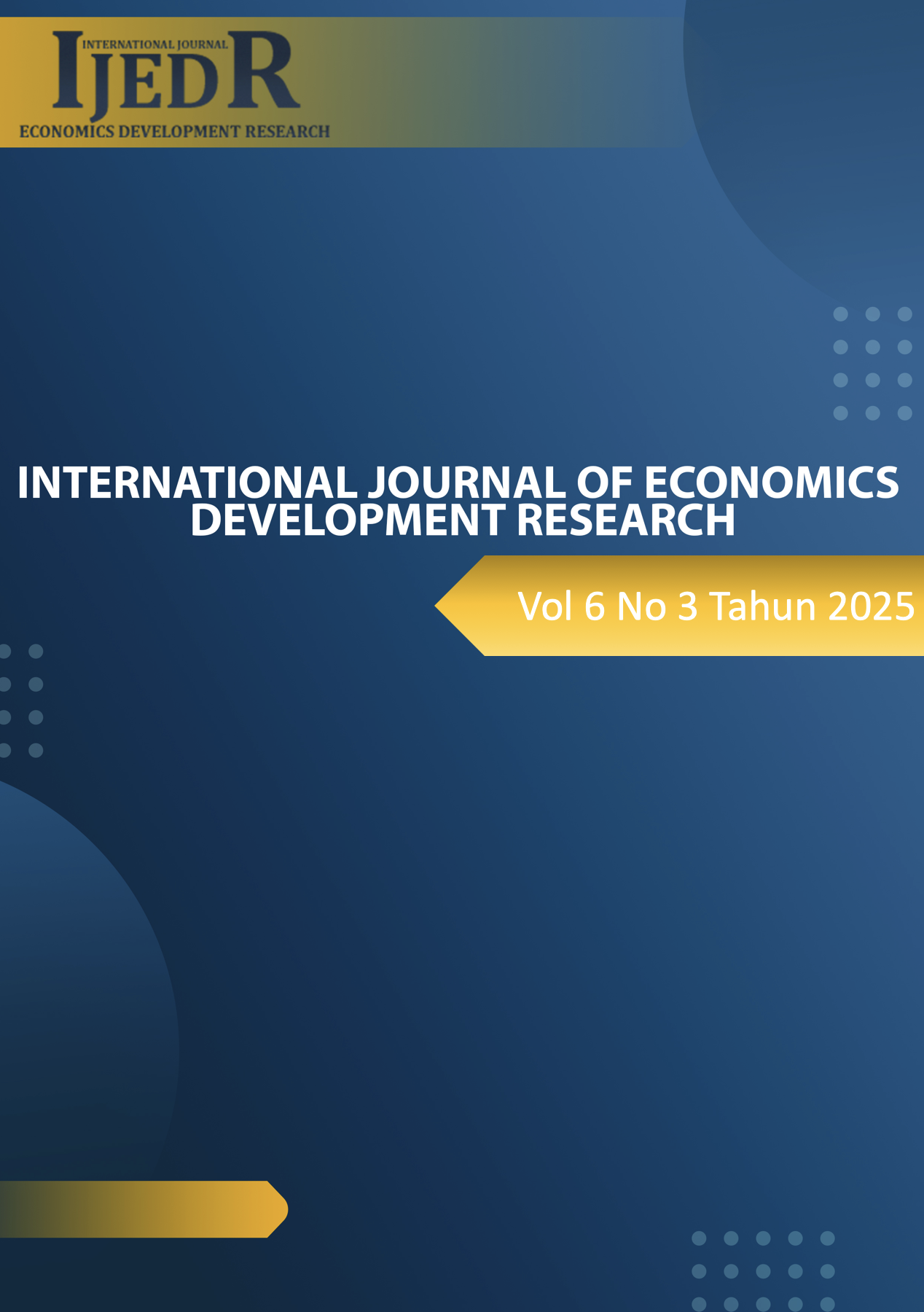Identification of Economic Structure Transformation of Banyuwangi Regency: A Study of Economic Sectors Using Location Quotient, Shift Share, and Klassen Typology Methods
DOI:
https://doi.org/10.37385/ijedr.v6i3.7942Keywords:
Economic Structure Transformation, Location Quotient, Shift Share, Klassen Typology, Regional Development, Sectoral AnalysisAbstract
This research aims to identify the transformation of the economic structure in Banyuwangi Regency during the period 2019-2023 by analysing the contribution of various economic sectors using Location Quotient (LQ), Shift Share, and Klassen Typology methods. The study adopts a descriptive quantitative approach, utilising secondary data obtained from the Central Bureau of Statistics (BPS), including the Gross Regional Domestic Product (GRDP) at constant prices. The LQ analysis reveals a gradual decline in the number of basic sectors, from five in 2019 to four in 2023, with the transport and warehousing sector losing its basic status due to reduced comparative advantage. The Shift Share analysis indicates a significant increase in the number of sectors with positive differential shift values, reflecting an expansion in regional competitiveness and the spread of economic growth to previously lagging sectors. Furthermore, the Klassen Typology analysis shows a shift in Banyuwangi's classification from Quadrant IV (relatively underdeveloped region) to Quadrant III (advanced but depressed region), suggesting a meaningful phase of catch-up growth. These findings demonstrate an ongoing structural transformation from primary to more diverse secondary and tertiary sectors, aligning with regional development theories that emphasise productivity enhancement and sectoral diversification. The study concludes that while Banyuwangi is on a promising trajectory towards a more balanced and resilient regional economy, sustained strategic efforts are needed to improve per capita income and further strengthen inter-sectoral linkages for long-term equitable development.
References
Ayuningtyas, F. J., Astuti, I. P., Apriliawan, D. I., & Shi, K. (2023). East Java Province: Economic structure and forecast GRDP analysis. Optimum: Jurnal Ekonomi dan Pembangunan, 13(2). https://doi.org/10.12928/optimum.v13i2.7958
Badan Pusat Statistik. (2023). Produk Domestik Regional Bruto Kab/Kota Provinsi Jawa Timur Menurut Lapangan Usaha 2018–2022 (p. 3).
Badan Pusat Statistik Kabupaten Banyuwangi. (2024). Produk Domestik Regional Bruto Kabupaten Banyuwangi Menurut Lapangan Usaha 2019–2023. Banyuwangi.
Fitrian, Z. (2018). Analisis transformasi ekonomi di Provinsi Kalimantan Timur. Jurnal Borneo Administrator, 14(2). https://doi.org/10.24258/jba.v14i2.326
Klassen, L. H. (1965). Methods of studying economic development of states. OECD.
Nabilla, N., Ciptawaty, U., Ratih, A. R. Y. T., Yuliawan, D., & Murwiati, A. (2023). Analysis of growth and changes in economic structure in 5 big cities on the island of Sumatra (Case Study 2017–2022). International Journal of Economics, Management and Accounting, 4(2), 178–200. https://ij.lafadzpublishing.com/index.php/IJEMA/article/view/145
Pratama, M. P. (2020). Analisis dan kontribusi sektor basis non-basis: Penentu potensi produk unggulan Kabupaten Kebumen. Jurnal Ilmiah Akuntansi dan Keuangan, 9(1). https://doi.org/10.32639/jiak.v9i1.313
Pratiwi, M. C. Y. (2017). Efek limpahan dan analisis pusat pertumbuhan Provinsi Kalimantan Tengah. Jurnal Kebijakan Pembangunan, 12(2).
Priana, W. (2017). Economic growth model location quotient (LQ) in East Java Province. Jurnal Ilmu Ekonomi dan Pembangunan, 16(1). https://doi.org/10.20961/jiep.v16i1.2352
Ridwan, M., et al. (2021). Pentingnya penerapan literature review pada penelitian ilmiah. Jurnal Masohi, 2(1). https://doi.org/10.36339/jmas.v2i1.427
Rosyidah, S. I. (2022). Analisis potensi sektor ekonomi pada kabupaten dan kota Provinsi Daerah Istimewa Yogyakarta. Jurnal Ekonomi, 27(3), 296–316. https://doi.org/10.24912/JE.V27I3.1111
Saifulloh, E. (2020). Analisis transformasi struktur perekonomian dalam sektor primer, sekunder dan tersier dengan analisis LQ dan Shift Share perspektif ekonomi Islam. Malaysian Palm Oil Council (MPOC), 21(1).
Saragih, J. R., et al. (2021). Komoditas unggulan dan potensial sektor pertanian Kabupaten Simalungun, Provinsi Sumatera Utara. Agro Bali: Agricultural Journal, 4(1). https://doi.org/10.37637/ab.v0i0.633
Sartika, N., & Sulistiawati, R. (2024). How is economic structure transformed? Evidence: West Kalimantan Province of Indonesia. Sriwijaya International Journal of Dynamic Economics and Business, 8(1), 45–64. https://doi.org/10.29259/sijdeb.v8i1.45-64
Sharazati, K., Primandhana, W. P., & Wahed, M. (2021). Analisis sektor unggulan di Kabupaten Sleman dan Kabupaten Gunungkidul. Syntax Idea, 3(6). https://doi.org/10.46799/syntax-idea.v3i6.1229
Sinta, D. (2024). Transformasi struktural: Faktor-faktor dan pengaruhnya terhadap disparitas pendapatan di Kalimantan Timur tahun 2012–2021. Retrieved November 11, 2024, from https://repository.uinjkt.ac.id/dspace/handle/123456789/80931
Sishidiyati, S., et al. (2022). Analisis shift share bagi penguatan daya saing daerah kabupaten/kota di Jawa Timur. Journal of Regional Economics Indonesia, 2(2). https://doi.org/10.26905/jrei.v2i2.7219
Woestho, C., & Sulistyowati, A. (2021). Prioritas pembangunan daerah dan pertumbuhan ekonomi pada Provinsi Daerah Istimewa Yogyakarta. Jurnal STEI Ekonomi, 30(01). https://doi.org/10.36406/jemi.v30i01.357





